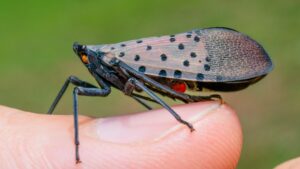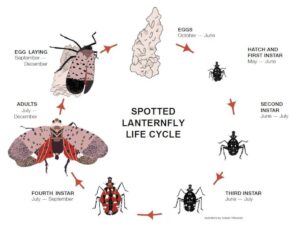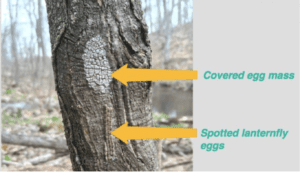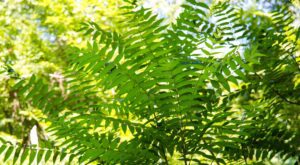
As our town grows and changes, we want to make sure our community stays healthy and that we look after our blossoming plants and gardens. However, an insect called the spotted lanternfly is causing our plants to be in peril! Right now, this species is in its nymph stage and will start developing into full adults. Take action and prevent them from further spreading and developing by killing them! In addition, it can be beneficial to start taking preventative measures in July against the lanternfly eggs for the next season. It is highly recommended to remove nearby trees of heaven; the trees of heaven will be effectively removed if an herbicide is applied in late July to Mid-October.
Scientific background
The spotted lanternfly is a destructive and invasive planthopper species that has been spreading throughout the Mid-Atlantic region. The infestation started in Pennsylvania about 8 years ago, and they arrived in Princeton about 2-3 years ago. In just a few generations, they have multiplied quickly and have become a common sight in many parts of Princeton.
Spotted lanternflies are not a pleasant thing to have in your backyard. They harm plants they feed on, thousands of them can completely swarm trees, and they leave behind a sticky substance which causes mold to develop.

It is important to know the spotted lanternfly’s life cycle to understand when different countermeasures work during the year. Spotted lanternflies hatch in late May and early June as very small nymphs. When in the nymph stage, they cannot fly and like crawling up the sides of any vertical objects – often trees. This is a perfect time to set up sticky traps around the trunks of trees that you notice have many spotted lanternfly nymphs. We recommend buying or making environmentally friendly traps because some traps can trap and kill other beneficial insects or even birds. During the summer, the spotted lanternfly grows into an adult. Insecticides, squashing, and traps can work on the adults with varying degrees of success. Finally, in the late fall and early winter, the spotted lanternflies start laying eggs. From November to May, removing their eggs is one of the best ways to slow their spread because just one egg mass can hold 50 eggs.

Eggs can be found on the undersides of surfaces and tree branches and have brownish/gray color. Spotted lanternflies can lay their eggs on any at surface including trees, cement, and wooden furniture. The eggs are a brownish color but are often covered by a white or gray protective covering. They are often cracked by the late spring. Egg masses can simply be removed by scraping them into a bag, and later discarding the bag after it is filled with rubbing alcohol.

The spotted lanternflies feed and lay eggs on many different plants including vines, rose bushes, maples, and river birches, but their favorite source of food are the trees of heaven. The tree of heaven is another invasive species that spreads quickly and inhibits the growth of nearby plants. They are recognizable by their doubled leaf formation which is uncommon in other local plants. Although Princeton township and homeowners removed many trees of heaven around Princeton earlier in the year, they have started to return again this summer. We do not recommend cutting them on your own because that will make more trees of heaven grow back. The best way is to have professionals carefully inject herbicide to kill the plant, or to inject insecticide to kill the spotted lanternfly that may feed on it.
Sighting and Dealing with the Insect
It is important to keep an eye out for these insects (their red wings with black freckles are most notable) on vehicles, buildings, surfaces (metal, wood, steel), gardens, and other places. Mercer County, in particular, is a lanternfly quarantine zone, meaning that vehicles or materials that are transporting into and out of the region could be harboring the pest. It is important that drivers with business vehicles in Princeton follow state transportation regulations set by the agricultural department to prevent further spread. To name a few checkpoints: check your vehicles for the spotted lanternfly before getting in, close windows when parking, and try parking away from heavily wooded areas with trees.
As for residents, if you spot the insect in your home yards, immediately kill the bug – please note the insect is not hazardous to humans – by stomping or squashing it. If you find the species in your garden or yard, there are some DIY spraying methods that could be used, like spraying mixtures of neem oil, dish soap, or vinegar. It is important to note the effectiveness/reliability of these homemade sprays is not known. In the case that large sections of properties, such as forested areas, are heavily infested, you may want to call local spraying services that offer professional lanternfly treatment.
For more information, you can check out other resources such as PennState Extension,
NJ Department of Agriculture and Viking Pest Control.

